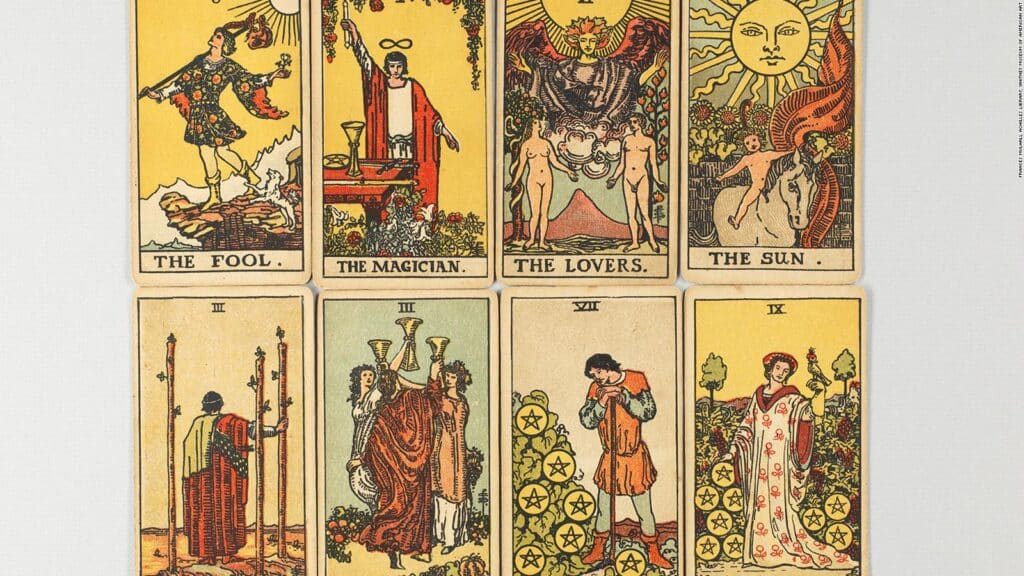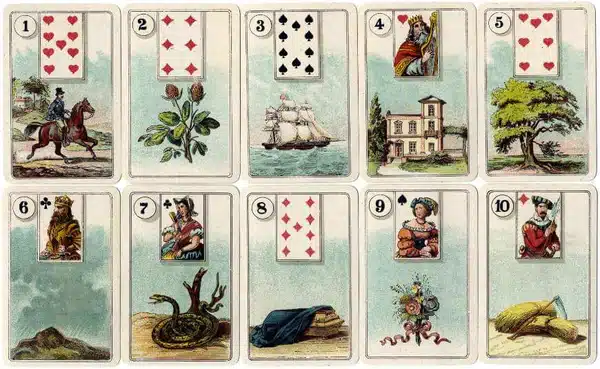Many psychic readers use tools to help stir their intuition and psychic abilities when they read for themselves or others, and one of the tools that many psychics use is cards. The use of cards for divination is known as cartomancy, and it can include tarot, oracle cards, which includes Lenormand, and playing cards.
Cartomancy Explained
Using playing cards for divination is often called cartomancy, but the term does count for using any card for divination. Some psychics disagree and do not consider any form of divination with cards other than playing cards as cartomancy. But cartomancy literally means using divination with a deck of cards; it does not specify playing cards only. Now, let’s briefly review each type of card deck used for divination.
Cartomancy: Divination With Tarot

Tarot cards contain 78 cards that consist of four suits which make up 56 cards, known as the Minor Arcana, and 22 cards, known as the Major Arcana. Of the 56 cards, you have 14 cards in each of the four suits: Wands, Swords, Cups, and Pentacles.
The cards go from Ace to ten, and four remaining cards in each suit are court cards: Page, Knight, Queen, and King. Each suit corresponds with the four elements, as Wands correspond with fire, Swords correspond with air, Cups correspond with water, and Pentacles correspond with earth.
Three main tarot styles include Marseille, Thoth, and Rider-Waite-Smith. Whatever technique works for the reader will be the suitable one for them. However, many tarot readers are the most comfortable with Rider-Waite-Smith, often referred to by its initials, RWS. The creators of the RSW deck are the author Arthur Evans Waite, the illustrator Pamela Coleman-Smith, and the publisher Rider, who published the deck in 1909.
Rider-Waite-Smith Deck
The RWS tarot deck is known as the primary deck and a classic, and many tarot teachers use this deck to teach. Therefore, it is known as a teaching deck. Many modern decks have the RWS style. Therefore, many tarot decks consist of cats, dogs, other animals, various fairy tales, takes on movies and different life themes, and even shows such as the Simpsons, which have traits of the RWS as deck creators have found ways to get creative with new decks but wanted to keep the RWS themes constant.
Marseille Deck
Tarot readers who do not like the RWS theme may use tarot decks with the Marseille or Thoth decks. First, let’s talk about Marseille. Marseille Tarot is an old 17th-century French deck and is an old complete tarot version. Early modern woodcuts influence newer Marseille tarot decks, as there are no images for the Minor Arcana other than the number of sticks, swords, chalices, and coins. Those who prefer Marseille decks over RWS decks are likely ones that become overwhelmed with too much imagery. (If you’re interested in learning more, check out our tarot history guide).
Thoth Deck
Finally, there is the Thoth-style deck. Aleister Crowley established the deck in the 1930s, and Lady Freida Harris painted it in the 1940s. However, it was not released to anyone until 1969, when publishing happened. Like the other decks, Thoth decks consist of 78 cards, but there are differences between Thoth RWS, such as the order of the Strength and Justice cards in the Major Arcana. Strength is assigned eight in the deck in the classic and modern variations of the RWS decks, and Justice is given 11.
In the Thoth deck, Justice is eight, and Strength is 11. There is also a difference in the court cards as in Thoth decks, there are Knight, Queen, Prince, and Princess, whereas, in RWS, there are Page, Knight, Queen, and King. There are other subtle differences with the other cards.
Tarot readers may switch from RWS to Thoth or Marseille and vice versa, but more often than not, whatever style of the tarot deck that readers started using when they began learning it, they will stick to that style.
For example, if a tarot reader began learning to read the tarot at a young age using the classic RWS deck, they would likely stick to using that style and may or may not start to collect newer decks and variations of RWS. You can also use playing cards to replace the Minor Arcana of tarot cards.
Using Playing Cards As A Replacement For Tarot
First, playing card cartomancy differs from using playing cards to replace the Minor Arcana of tarot cards. If you intend to use playing cards to do tarot readings, that is what you do. Many people like to keep a deck of playing cards with them if they go somewhere if they need to do a tarot reading in a pinch. Playing cards are portable, though some tarot cards are small.
You can use playing cards only to do a tarot reading of the Minor Arcana. For example, clubs would be equivalent to Wands, Spades are equal to Swords, Hearts are equivalent to Cups, and Diamonds are identical to Pentacles. However, playing card cartomancy differs from tarot, which I will get to later. Let’s now go over Lenormand cards.
Cartomancy: Divination With Lenormand Cards

Lenormand cards are another form of card system for divination, and the late cartomancer and French fortune teller, Marie Anne Lenormand, from the 18th century, established the Lenormand system. Lenormand cards are very different from tarot cards as there is no Major or Minor Arcana, and instead of 78 cards, there are 36 Lenormand cards in a deck. Lenormand cards are also a concrete way of fortune telling, whereas tarot digs into your subconscious, and you must intuitively pick up the messages from the reading.
Also, unlike tarot, there are “positive” and “negative” cards, and some are neutral. You may think of cards such as Five of Swords or the Devil as negative cards, but seasoned tarot readers can see there are positive aspects of those cards too. However, with Lenormand, there are some genuinely negative cards, such as the snake or mice, and positive cards, such as clover or bouquet.
You also do not use reversals regarding Lenormand as you do with tarot. Therefore, Lenormand and tarot are very different card systems. There are symbols on Lenormand cards, like tarot cards; one of the symbols you will see on Lenormand cards is a playing card on the corner.
Also, unlike tarot, you use particular spreads such as the Grand Tableau with Lenormand, whereas, with tarot, you can get creative. You also have to read at least two cards in the Lenormand deck together to get a reading, whereas you can pull a single tarot card, such as the card of the day reading. Now let’s talk about a different set of cards, which are oracle cards.
Cartomancy: Divination With Oracle Cards
Oracle cards are freeform, as there are no rules. A significant difference between oracle cards, Lenormand, and tarot cards is that oracle cards are arranged differently. Common themes around oracle cards are that there are cards with inspiring messages to help you get into a positive mind frame. An individual who customizes their oracle deck can decide how many cards to put in the deck, its shape, the images and meanings of the cards, and its purpose.
If you want to create an oracle deck, it also means customizing your theme. An interpretation booklet is usually included with an oracle deck, but you will get that too with tarot and Lenormand decks. The reader can understand the images and words that you have created. It comes down to personal preference when making a tarot, Lenormand, or oracle deck.
Tarot cards are great if you prefer a preset structure to meet your creative needs, and Lenormand cards are excellent if you want concrete answers to your question. The oracle deck is better if you start from scratch and design your rules and images. Finally, the last type of cards used in cartomancy are playing cards.
Cartomancy: Divination With Playing Cards
Divination with playing cards is chiefly cartomancy, but using all cards for divination is technically the practice. Cartomancy with playing cards has been a practice since the 17th century but likely has been around longer. They have four suits: Spades corresponding to air, Clubs corresponding to fire, Diamonds corresponding to earth, and Hearts corresponding to water. It sounds like the Minor Arcana tarot, but it is different.
Readers who use playing cards for divination will show you when and how things will happen through the cards. Yes, there is free will, and even that can change things, but playing card cartomancy is the closest way to do true fortune-telling, more so than the other cards listed above. Therefore, if you want to know the answer, you are better off getting a playing card cartomancy reading than looking at potential outcomes, which tarot and Lenormand do.
Free Will In Cartomancy
Remember that you can always change your path if you don’t like the outcome that the playing cards show if you ask a fortune teller how something would turn out. No matter what any cards tell you, the future is in your hands regarding things you can control. When it comes to anything you cannot control, that is a harsh fact of life.